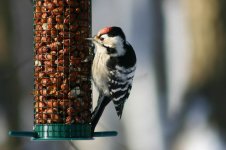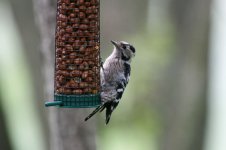John Cantelo
Well-known member
Another thread suggests that for a lot of UK birdwatchers Lesser-spotted Woodpecker is the No1 'must-see-species' for 2007 so I though I'd put together some tips!
The problem is the Lesser-spotted Woodpeckers ….
a) …... are small critters in large trees tucked away in still bigger woods!
b) …… have declined alarmingly (by 75%)
c) …… tend to frequent the higher canopy of big trees
d) …… hide behind those irritating things called leaves
The trick is to discover strategies to neutralise these problems!
The first thing has to be …. find your wood! OK I've found the Lesser-spots in single isolated oaks, small clumps of wayside trees, spindly copses and the like, but these more marginal habitats seem to be where they have declined most in recent years. For your best chance look for a good sized ancient woodland with plenty of old trees (esp. oaks). If you don't know any old woodland read your county avifauna and check out your nearest RSPB/county/woodland trust reserves (these organisations tend to favour buying old woodland).
For more specific and up-to-date info get hold of your latest county bird report (easy since you're already a member ….) and read up on the species' fortunes. Talk to those competent looking birders you see around - at best they'll point you in the right direction and at worst commiserate 'cos they haven't seen them either! This should help pinpoint where to look as some old 'regular' sites no longer have them (or far fewer of them). Locally I can think of two or three sites which I'd have recommended searching a few years back which I'd not do today.
I've not kept an accurate record, but I'd guess that over 90% of the Lesser-spots I see I hear first so focus your search on that time of the year when they're drumming. In the UK drumming starts in late January and continues through February, but only starts going 'full throttle' in March and April. It starts to tail off in May and dribbles away through June. As the nature of the soundboard can radically alter the timbre of the note the key is to realise that,compared to Great-spotted Woodpecker, a Lesser's drum-roll tends to be longer (usually twice as long - c1.5 secs), slightly slower , more evenly articulated and more readily repeated. It's actually easier to recognise than described so listen to it on a bird "song" CD (and if you haven't get one of the freebies offered by 'The Independent' next week). Even if you're still not sure simply follow up all drumming to see the 'culprit' - every time it's a GSW, the more likely it is that the next one is going to be a Lesser-spot! However, if you hear a ringing 'pee-pee-pee' call (a bit like a Kestrel's) it's a Lesser-spot - this is a clincher. Since both drumming and the calls carry some way, you've now reduced the effective size of the search area to reasonable proportions. You're also going to be looking in March or early April (or earlier) as those pesky leaves won't be around! Remember too that Lesser-spots will probably be high up and feeding on the outer limbs of trees. Like so many birds your chances are increased if you're looking early (dawn is a lovely time of day!) on a still sunny day. Until you're 'in the know' finding a Lesser-spot is never easy, but do your homework, keep alert to drumming/calls, your eyes peeled and pick your day carefully - do all this and you will see one! Perhaps not the first time and maybe not the second, but if you've got it right I'll be disappointed if you've not done so by your third attempt!!!
John
The problem is the Lesser-spotted Woodpeckers ….
a) …... are small critters in large trees tucked away in still bigger woods!
b) …… have declined alarmingly (by 75%)
c) …… tend to frequent the higher canopy of big trees
d) …… hide behind those irritating things called leaves
The trick is to discover strategies to neutralise these problems!
The first thing has to be …. find your wood! OK I've found the Lesser-spots in single isolated oaks, small clumps of wayside trees, spindly copses and the like, but these more marginal habitats seem to be where they have declined most in recent years. For your best chance look for a good sized ancient woodland with plenty of old trees (esp. oaks). If you don't know any old woodland read your county avifauna and check out your nearest RSPB/county/woodland trust reserves (these organisations tend to favour buying old woodland).
For more specific and up-to-date info get hold of your latest county bird report (easy since you're already a member ….) and read up on the species' fortunes. Talk to those competent looking birders you see around - at best they'll point you in the right direction and at worst commiserate 'cos they haven't seen them either! This should help pinpoint where to look as some old 'regular' sites no longer have them (or far fewer of them). Locally I can think of two or three sites which I'd have recommended searching a few years back which I'd not do today.
I've not kept an accurate record, but I'd guess that over 90% of the Lesser-spots I see I hear first so focus your search on that time of the year when they're drumming. In the UK drumming starts in late January and continues through February, but only starts going 'full throttle' in March and April. It starts to tail off in May and dribbles away through June. As the nature of the soundboard can radically alter the timbre of the note the key is to realise that,compared to Great-spotted Woodpecker, a Lesser's drum-roll tends to be longer (usually twice as long - c1.5 secs), slightly slower , more evenly articulated and more readily repeated. It's actually easier to recognise than described so listen to it on a bird "song" CD (and if you haven't get one of the freebies offered by 'The Independent' next week). Even if you're still not sure simply follow up all drumming to see the 'culprit' - every time it's a GSW, the more likely it is that the next one is going to be a Lesser-spot! However, if you hear a ringing 'pee-pee-pee' call (a bit like a Kestrel's) it's a Lesser-spot - this is a clincher. Since both drumming and the calls carry some way, you've now reduced the effective size of the search area to reasonable proportions. You're also going to be looking in March or early April (or earlier) as those pesky leaves won't be around! Remember too that Lesser-spots will probably be high up and feeding on the outer limbs of trees. Like so many birds your chances are increased if you're looking early (dawn is a lovely time of day!) on a still sunny day. Until you're 'in the know' finding a Lesser-spot is never easy, but do your homework, keep alert to drumming/calls, your eyes peeled and pick your day carefully - do all this and you will see one! Perhaps not the first time and maybe not the second, but if you've got it right I'll be disappointed if you've not done so by your third attempt!!!
John







